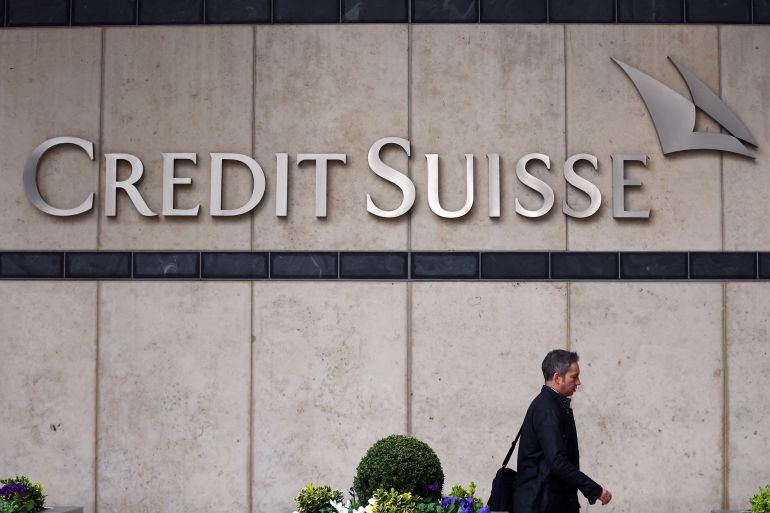UBS is wealth management behemoth after Credit Suisse takeover
As a result of biggest banking deal since 2008 crisis, UBS will oversee $5 trillion in assets, giving it the lead position in key markets.

UBS on Monday said it had completed its emergency takeover of embattled local rival Credit Suisse, creating a giant Swiss bank with a balance sheet of $1.6 trillion and greater muscle in wealth management.
Announcing the biggest banking deal since the 2008 global financial crisis, UBS Chief Executive Sergio Ermotti and Chairman Colm Kelleher said it would create challenges but also “many opportunities” for clients, employees, shareholders, and Switzerland.
Keep reading
list of 4 itemsFive things to expect from Trump’s appearance in Florida court
‘Historic moment’: First climate action case goes on trial in US
Major US highway could take months to repair after collapse
The group will oversee $5 trillion of assets, giving UBS a leading position in key markets it would otherwise have needed years to grow in size and reach. The merger also brings to an end Credit Suisse’s 167-year history, marred in recent years by scandals and losses.
Having peaked at more than 82 Swiss francs ($90.11) in 2007, Credit Suisse, plagued by scandals and heavy losses, plumbed to ever-deeper lows, closing at less than one franc ($1.10) on Monday.
Credit Suisse shares closed up roughly one percent on their last day of trading, while UBS shares were also up around 0.8 percent.
The two banks jointly employ 120,000 people worldwide, although UBS has already said it will be cutting jobs to reduce costs and take advantage of synergies.
UBS announced a string of management changes including at Credit Suisse AG, which is now a subsidiary that will be run separately.
Of the more than 160 leaders who are being confirmed or appointed today at UBS, over a fifth are joining from Credit Suisse, a spokesperson for UBS said.
Andre Helfenstein, head of Credit Suisse’s domestic business, will remain in his role. UBS has said it is considering all strategic options for the unit.
Closing rush
UBS agreed on March 19 to buy the lender for a knockdown price of 3 billion Swiss francs ($3.3bn) and up to 5 billion francs ($5.5bn) in assumed losses in a rescue that Swiss authorities orchestrated to prevent a collapse in customer confidence from pushing Switzerland’s number-two bank over the edge.
On Friday, UBS finalised an agreement on the conditions of a 9 billion Swiss franc ($10bn) public backstop for losses from winding down parts of Credit Suisse’s business.
UBS sealed the takeover in less than three months – a tight timetable given its scale and complexity – in a race to provide greater certainty for Credit Suisse clients and employees, and to stave off departures.
Myths debunked
However, the deal, which saw the state bankroll the rescue, exposed two myths: that Switzerland was entirely predictable, and that the banks’ problems would not rebound on taxpayers.
“It was supposed to be the end of too-big-to-fail and state-led bailout,” said Jean Dermine, professor of banking and finance at the Institut Européen d’Administration des Affaires (INSEAD), adding that the episode showed this central reform after the global financial crisis had not worked.
The rescue also showed that even big global banks are vulnerable to bouts of bank panic, said Arturo Bris, professor of finance and director of the IMD World Competitiveness Center.
What’s more, the disappearance of Credit Suisse’s investment bank, which UBS has said it will seek to cut back significantly, marks yet another retreat of a European lender from securities trading, which is now largely dominated by United States firms.
Since the global financial crisis, many banks have pared back their global ambitions in response to tougher regulations.
Swiss regulator FINMA, which came under fire for its handling of the downfall of the country’s second-largest bank, said one of the most pressing goals for the newly merged bank was to quickly reduce the risk of the former Credit Suisse investment bank.
UBS is set to book a massive profit in second-quarter results after buying Credit Suisse for a fraction of its so-called fair value.
Ermotti has, however, warned that the coming months will be “bumpy” as UBS gets on with absorbing Credit Suisse, a process UBS has said will take three to five years.
Presenting the first snapshot of the new group’s finances last month, UBS underscored the high stakes involved by flagging tens of billions of dollars of potential costs and benefits, but also uncertainty surrounding those numbers.
New challenges
Possibly the first challenge for Ermotti, brought back to steer the merger, will be a politically fraught decision about the future of Credit Suisse’s “crown jewel” – the bank’s domestic business.
Bringing it into UBS’s fold and combining the two banks’ largely overlapping networks could produce significant savings, and Ermotti has indicated that as a base scenario.
But he will need to weigh that against public pressure to preserve Credit Suisse’s domestic business with its own brand, identity and, critically, workforce.
Analysts say public concerns the new bank will be too big – with a balance sheet roughly double the size of the Swiss economy – means UBS might need to tread carefully to avoid being exposed to even tougher regulation and capital requirements that its new scale would call for.
They also warn that uncertainty inevitably caused by a takeover of such scale can leave UBS struggling to retain staff and customers and that it remained an open question whether the deal can deliver value for shareholders in the long run.